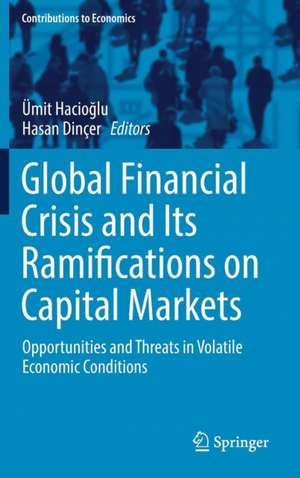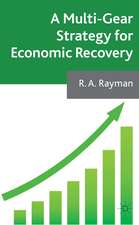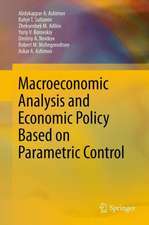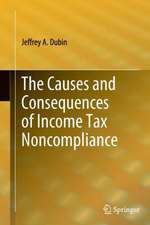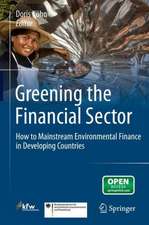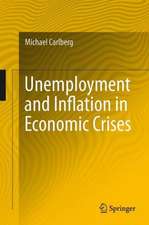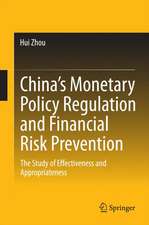Global Financial Crisis and Its Ramifications on Capital Markets: Opportunities and Threats in Volatile Economic Conditions: Contributions to Economics
Editat de Ümit Hacioğlu, Hasan Dinçeren Limba Engleză Hardback – 9 feb 2017
| Toate formatele și edițiile | Preț | Express |
|---|---|---|
| Paperback (1) | 1016.96 lei 6-8 săpt. | |
| Springer International Publishing – 3 mai 2018 | 1016.96 lei 6-8 săpt. | |
| Hardback (1) | 1023.42 lei 6-8 săpt. | |
| Springer International Publishing – 9 feb 2017 | 1023.42 lei 6-8 săpt. |
Din seria Contributions to Economics
- 18%
 Preț: 1109.92 lei
Preț: 1109.92 lei - 17%
 Preț: 361.01 lei
Preț: 361.01 lei - 18%
 Preț: 1001.81 lei
Preț: 1001.81 lei -
 Preț: 90.83 lei
Preț: 90.83 lei - 24%
 Preț: 657.06 lei
Preț: 657.06 lei - 15%
 Preț: 649.06 lei
Preț: 649.06 lei - 18%
 Preț: 1027.83 lei
Preț: 1027.83 lei -
 Preț: 283.93 lei
Preț: 283.93 lei - 15%
 Preț: 644.95 lei
Preț: 644.95 lei - 15%
 Preț: 638.24 lei
Preț: 638.24 lei - 15%
 Preț: 635.47 lei
Preț: 635.47 lei - 15%
 Preț: 634.00 lei
Preț: 634.00 lei -
 Preț: 394.29 lei
Preț: 394.29 lei - 15%
 Preț: 636.80 lei
Preț: 636.80 lei - 18%
 Preț: 723.69 lei
Preț: 723.69 lei - 15%
 Preț: 637.78 lei
Preț: 637.78 lei -
 Preț: 392.75 lei
Preț: 392.75 lei -
 Preț: 383.33 lei
Preț: 383.33 lei - 15%
 Preț: 637.28 lei
Preț: 637.28 lei - 15%
 Preț: 636.80 lei
Preț: 636.80 lei - 18%
 Preț: 950.96 lei
Preț: 950.96 lei - 15%
 Preț: 634.68 lei
Preț: 634.68 lei -
 Preț: 387.38 lei
Preț: 387.38 lei - 15%
 Preț: 647.27 lei
Preț: 647.27 lei - 15%
 Preț: 636.63 lei
Preț: 636.63 lei -
 Preț: 384.70 lei
Preț: 384.70 lei -
 Preț: 388.52 lei
Preț: 388.52 lei - 15%
 Preț: 639.73 lei
Preț: 639.73 lei -
 Preț: 385.62 lei
Preț: 385.62 lei - 15%
 Preț: 641.85 lei
Preț: 641.85 lei - 20%
 Preț: 649.60 lei
Preț: 649.60 lei - 15%
 Preț: 641.71 lei
Preț: 641.71 lei -
 Preț: 387.96 lei
Preț: 387.96 lei - 15%
 Preț: 645.47 lei
Preț: 645.47 lei -
 Preț: 385.08 lei
Preț: 385.08 lei - 15%
 Preț: 646.62 lei
Preț: 646.62 lei -
 Preț: 383.33 lei
Preț: 383.33 lei - 15%
 Preț: 638.43 lei
Preț: 638.43 lei -
 Preț: 381.21 lei
Preț: 381.21 lei - 15%
 Preț: 642.51 lei
Preț: 642.51 lei - 15%
 Preț: 637.78 lei
Preț: 637.78 lei - 15%
 Preț: 641.71 lei
Preț: 641.71 lei -
 Preț: 384.70 lei
Preț: 384.70 lei -
 Preț: 379.86 lei
Preț: 379.86 lei -
 Preț: 378.34 lei
Preț: 378.34 lei - 15%
 Preț: 641.71 lei
Preț: 641.71 lei -
 Preț: 381.00 lei
Preț: 381.00 lei - 15%
 Preț: 644.95 lei
Preț: 644.95 lei -
 Preț: 386.00 lei
Preț: 386.00 lei -
 Preț: 382.75 lei
Preț: 382.75 lei
Preț: 1023.42 lei
Preț vechi: 1248.08 lei
-18% Nou
Puncte Express: 1535
Preț estimativ în valută:
195.88€ • 203.73$ • 164.15£
195.88€ • 203.73$ • 164.15£
Carte tipărită la comandă
Livrare economică 14-28 martie
Preluare comenzi: 021 569.72.76
Specificații
ISBN-13: 9783319470207
ISBN-10: 3319470205
Pagini: 678
Ilustrații: XIX, 659 p. 113 illus., 104 illus. in color.
Dimensiuni: 155 x 235 x 37 mm
Greutate: 1.12 kg
Ediția:1st ed. 2017
Editura: Springer International Publishing
Colecția Springer
Seria Contributions to Economics
Locul publicării:Cham, Switzerland
ISBN-10: 3319470205
Pagini: 678
Ilustrații: XIX, 659 p. 113 illus., 104 illus. in color.
Dimensiuni: 155 x 235 x 37 mm
Greutate: 1.12 kg
Ediția:1st ed. 2017
Editura: Springer International Publishing
Colecția Springer
Seria Contributions to Economics
Locul publicării:Cham, Switzerland
Cuprins
Section I. 2008-2009 Financial Crisis, International Financial Institutions and Regulation.- Chapter 1. The 2008-2009 Financial Crisis in Historical Context.- Chapter 2. Global Economy at Turmoil.- Chapter 3. International Financial Centers after the 2008-2009 Global Financial Crisis.- Chapter 4. Economic Crisis and the Changes in Functioning of International Financial Institutions: The Case of European Developing Countries.- Chapter 5. Deindustrialization, Public Debts and Euro Crisis.- Chapter 6. Public debt management in developed economies during the crisis.- Chapter 7. Fiscal Framework Changes in European Monetary Union Before and After Sovereign Debt Crisis.- Chapter 8. The Impact of the Eurozone Crisis on Turkish Foreign Trade.- Chapter 9. Regulating Financial Markets after the Global Crisis.-Chapter 10. Fiscal Sustainability in the G-7 Countries.-Chapter 11. Monetary Coordination and Regulation Policies of Spillover Effects on Asset Dynamics.- Chapter 12. Is the link between the Real and Financial sectors affected by mechanism of governance? A cross-country analysis in Asia.- Section II. Assessment of Financial Stability in Emerging Markets and Business Cycles.- Chapter 13. External Financial Conditions and Slower Growth in Emerging Economies – 2013–2015.- Chapter 14. Mortgaging the Future? Contagious Financial Crises in the Recent Past and their Implications for BRICS Economies.- Chapter 15. Assessment of Financial Stability in Emerging Economies: Evidence from Nigeria.- Chapter 16. Emerging Market Economies and International Business Cycle Fluctuations.- Chapter 17. Financial Conditions Index as a Leading Indicator of Business Cycles in Turkey.- Chapter 18. Feasibility of Financial Inclusion Mission in India under Reform and Global Financial Crisis.- Chapter 19. Renewable Energy Financing with a Sustainable Financial System Following The 2008 Financial Crisis in Developing Countries.- Chapter 20. The Impact of Russian Economy on the Trade, Foreign Direct Investment and Economic Growth of Turkey: Pre- and Post-Global Financial Crisis.- Chapter 21. Export Diversification in Emerging Economies.- Chapter 22. Equity and Debt Financing Strategies to fuel Global Business Operations during Crisis. Section III. Market Anomalies and Price Fluctuations in Capital Markets during Crisis.- Chapter 23. Stock Market Development and Economic Growth: The Case of MSCI Emerging Market Index Countries.- Chapter 24. Turkish Banking System: Maturing with Crises.- Chapter 25. Investigating the Causality Relationship between Liquidity and Financial Performance in Turkish Banking Sector: A Pre and Post 2008 Financial Crisis Assessment.- Chapter 26. Market Risks Instruments and Portfolio Inflows in African Frontier Economies.- Chapter 27. The Systemic Benefits of Islamic Banking and Finance Practices: A Comparative Study.- Chapter 28. Determinants of the Credit Risk in Developing Countries after Economic Crisis: A Case ofTurkish Banking Sector.- Chapter 29. Credit Risk Evaluation of Turkish Households Aftermath the 2008 Financial Crisis.- Chapter 30. International Credit Default Swaps Market during European Crisis: A Markov Switching Approach.- Chapter 31. Does reputation still matter to credit rating agencies?.- Chapter 32.Price Fluctuations in Econophysics.- Chapter 33. Forecasting Emerging Market Volatility in Crisis Period: Comparing Traditional GARCH with High-Frequency Based Models.- Chapter 34. Calendar Anomalies in Stock Markets during Financial Crisis: The S&P 500 Case.- Chapter 35. Day of the Week Effect in the Stock Markets of Fragile Five Countries after 2008 Global Financial Crisis.- Chapter 36.
Market Volatility, Beta, and Risks in Emerging Markets.- Section IV. Impact of Crisis, Economic Recovery and Sectoral Developments.- Chapter 37. The Relationship between Firm Size and Export Sales: Sector or Size, What Matters?.- Chapter 38. The Relationship between Economic Development and Female Labor Force Participation Rate – A Panel Data Analysis.- Chapter 39. The impact of the 2008-2009 global financial crises on employment creation and retention in the Platinum Group Metals (PGMs) mining sub-sector in South Africa.- Chapter 40.
The effects of the crisis on nautical tourism: an analysis of the Italian situation regarding port features, linked economic activities and taxation.- Chapter 41. Shipbuilding in Italy at the end of the crisis. Is there a road to recovery?.- Chapter 42. Life Insurance reforms and Capital formation development: Lessons for Nigeria.- Chapter 43. Innovation during and beyond the economic crisis.
Textul de pe ultima copertă
This book assesses the 2008-2009 financial crisis and its ramifications for the global economy from a multidisciplinary perspective. Current market conditions and systemic issues pose a risk to financial stability and sustained market access for emerging market borrowers. The volatile environment in the financial system became the source of major threats and some opportunities such as takeovers, mergers and acquisitions for international business operations. This volume is divided into six sections. The first evaluates the 2008–2009 Global Financial Crisis and its impacts on Global Economic Activity, examining the financial crisis in historical context, the economic slowdown, transmission of the crisis from advanced economies to emerging markets, and spillovers. The second section evaluates global imbalances, especially financial instability and the economic outlook for selected regional economies, while the third focuses on international financial institutions and fiscal policy applications. The fourth section analyzes the capital market mechanism, price fluctuations and global trade activity, while the fifth builds on new trends and business cycles to derive effective strategies and solutions for international entrepreneurship and business. In closing, the final section explores the road to economic recovery and stability by assessing the current outlook and fiscal strategies.
Caracteristici
Provides a comprehensive overview of the financial crisis and its implications for the economy Helps to understand strategic planning under volatile economic conditions for top managers Generates proactive strategies for Global Financial Institutions on the basis of economic assessments
